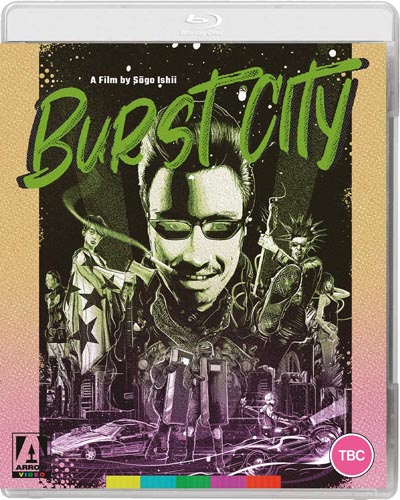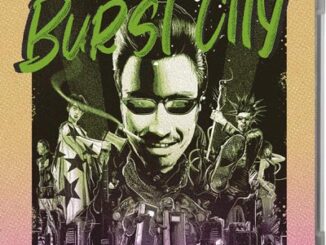Burst City (1982)
Directed by: Gakuryû Ishii
Written by: Jûgatsu Toi
Starring: Kansai Eto, Michirô Endô, Shigeru Izumiya, Takanori Jinnai
AKA BAKURETSU TOSHI
JAPAN
ON BLU-RAY NOW, from ARROW VIDEO
RUNNING TIME: 119 mins
REVIEWED BY: Dr Lenera
In a dystopian future, a yakuza boss is planning the construction of a nuclear power plant in Tokyo. The trouble is, it’s in an area that’s owned by several punk gangs who are constantly at war with each other, and in one particular locale two bands, the Rockers and the Roosters, are battling for supremacy. Into this fraught environment come two mute bikers seemingly looking for work and possibly also on another, more dangerous, mission. And then there’s the prostitute who’s pimped out to the same and very sadistic gang boss….
I suppose I should probably begin this review with an apology to both our friends at Arrow Films and to our veteran readers. I usually comment in some detail on the picture quality and the special features when reviewing a disc, but I’m not going to do so for Burst City because I’m already late writing this review and have several more to do in what will be a particular busy week for us at HCF; therefore I don’t really have to time to even just watch the extras, though I did skim the internet and find out a little bit to tell you about this curious film which by rights I ought to have hated. The reason? It’s chock-full of one of my pet hates, ‘shakycam’; little annoys me more than having a potentially great action scene ruined by the camera being wobbled about so I can barely see what’s going on and sometimes even feel physically sick. The final half hour of Burst City is non-stop ‘shakycam’ and became almost unwatchable in places to my eyes but before that the mixture of cyberpunk, gangster and teen rebellion movies with a concert film was rather enticing. It doesn’t really hang together and seems rather slapdash in many respects, at times even coming across as if they just edited some of the scenes in randomly [which actually is almost what happened] but it has a raw energy and a powerful anti-authoritarian streak which grab you and may make you want to go out and express yourself at the top of your voice even in these strange times that we are currently living in. And even the ‘shakycam’, as much as I disliked it, can be seen to have a point, because director Sogo Ishii clearly attempted to make the feel of punk music the overall aesthetic of his film
Ishii’s first two features were shot on 16mm at college and the second of those, the punk biker movie Crazy Thunder Road, was a hit for Toei Studios when they picked it up and released it. They offered Ishii a considerably larger budget to go off and make whatever he wanted, but the large-scale science fiction project he and co-writer Mitsuhiko Akita intended would have still cost too much, so they heavily scaled things down, removing aliens and spaceships, and reworked their treatment as Burst City. It was made right in the middle of the punk movement in Japan, so Ishii featured musicians from all three of the major punk hubs in Japan; Tokyo, Kyushu and Kansai. Contemporary punk musicians took on most of the leading acting roles in the film as well as performing songs. Ishii was virtually left alone during the shoot, a shoot where cast and crew lived on the post-apocalyptic set that they built. Ishii used 16mm again, but the production went over schedule and over budget, with as much partying taking placed as filmmaking, so he eventually he had to stop filming despite many scenes not having been shot. What was filmed wasn’t even logged, so he and editor Junji Sakamoto struggled to find matching pieces and didn’t even have enough money for a proper editing suite. This explains the disjointed nature of the end result, a film that Ishii still thinks as being unfinished. It wasn’t a commercial success either, though was quite influential, particularly on the work of Shinya Tsukamoto and Takashi Miike.
There’s a terrific opening as we adopt the POV of a motorbike rider driving through various parts of Tokyo by day and by night; sometimes the imagery becomes a virtually abstract mix of lights and lines, already showing that Ishii has chops and bravery as a filmmaker even if I don’t always like what he chooses to do. Then we get some near-pornographic shots of parts of the motorbike, before we cut to our nefarious main villain in his car talking business; and no, I’m not being lazy, the characters in this film don’t seem to have names. Next we meet our two riders properly; one’s very short and one has spiky armour on his arm and what looks like a Norman helmet. They never say a word these two, unless you count “ah”, but that serves them well when they’re discovered sleeping in a building that’s the headquarters of a violent gang and the members think they’re totally stupid so they take pity on them. The duo stop and look at a sign for a new waterway and imaging it being on fire, though their mission is actually something very different. We then we cut to a busy though impoverished street where, in black and white, somebody’s trying to get everyone to come and see a gig. The preparation by the band is dwelt upon with reverence, and one member even smashes his guitar against a wall before he goes on stage rather than while he’s on it! Now that’s the punk spirit. The camera whirls around and ducks and dives during the first song and, I have to admit, it’s quite exhilarating; we feel some of the dizzying energy of what it would have been like to actually be there. The song’s pretty good too; obviously being translated from Japanese means it doesn’t always read entirely right, but we can relate to lines about the world spinning round and, along with the catchy refrain, it has a Madness-vibe to it.
Punks and prostitutes dance [some of them looking like they’re having a fit] to another song with a great rhythmic backing, though I did wonder if lines like, “I gotta trash any place till dawn” and “when I get a girl I’ve got to keep banging all night long” were meant as parodic before I came to the conclusion that they weren’t. The camera explores this place so we get a real sense of this environment. And then it’s here we get the introduction of a subplot which seems separate from everything else despite one of the two men involved being the main villain. Said person arrives in this ghetto and demands a woman, so the resident pimp gives him one of his girls. However, the boss is into S & M and the girl is soon sporting deep wounds on her back. The pimp is supposedly in love with her but still keeps pimping her out to him even though he hurts her. I guess he thinks, possibly rightly, that they’ll be trouble for him if he doesn’t comply, but the love scene between pimp and hooker is both tender and queasy at the same time; this probably sounds ridiculous but if you watch the film you’ll see what I mean. Even though things do tie in towards the end, all this doesn’t seem to quite fit into this film, neither its style nor its manner; maybe there was footage never shot that would have given it more point. I suppose it’s there to ram home how nasty the yakuza, who seem to be the real rulers of Tokyo here, are, but for me it jarred with the film’s overall spirit, and scenes such as two punks taunting each other in a highly over the top manner just before a car race only for by far the most arrogant of the two to have an accident seconds after the start – but not being particularly bothered because his sunglasses are still okay.
Things are fairly aimless for much of the first half; we’re introduced to various characters and gangs but rarely get to know them and often soon move on, though the musical score, often consisting of drum rhythms, does its best to keep the pace going and adds a huge amount of suspense at times. There’s some emphasis on humour; I really liked the contrast between one gang who wake up and discuss in a relaxed fashion what they’re going to today, and another where somebody actually has to walk along behind people making sure that they’re concentrating 100% on their leader’s speech. There’s also some battling between bands that becomes a real battle in what might be the highlight of the whole film; it’s both exciting and funny. Plotting does become more focused as things heat up more and more, though unfortunately the ‘shakycam’ totally takes over in the final quarter. There’s a hell of a lot of action, and it ought to be exciting and all this rebellion rousing, but at times it’s just a blur. Even during an important flashback it’s not entirely clear what’s happening, though one has to admire Ishii and his cinematographer Norimichi Kasamatsu for experimenting with and combining various techniques – from undercranked shots to odd angles – to give everything a fast, anarchic feel, and even the graininess of the picture, especially during the black and white footage, comes across as an important part of the experience. The one time they linger on something for some time, the camera keeping still, is for a rather odd moment where one character is terribly sad at something which has happened and almost seems like he’s going to perform necrophilia; Ishii was no doubt trying to be really moving, but the scene instead comes off as laughable due to the lousy staging.
Songs are mainly positioned in the first and final thirds. Acting tends to be mannered and delivered in simple, broad strokes; it suits the project. Sadly women are just whores or girlfriends and with the one exception aren’t really given the chance to make an impression. Odd leftovers from the science fictional original conception, like some white robot or robot-like police towards the end, remain, while clothes and hairstyles are often a variety of strangeness – though of course the latter won’t be anything new to viewers of the likes of Mad Max 2 and Bronx Warriors which may have inspired some things here. Going back to staging, what certainly isn’t lousy staging are the gig scenes, from the sweaty mosh pits to the thrilling performances which would be thrilling even without the lyrics being translated into English; these Japanese punk bands really rock. This particular genre of pop music isn’t really my thing apart from a few specific groups, but I had an urge to listen to some after watching the film, Ishii’s deep love for not just this music but its feel and meaning infusing so much of it that it too over me a bit, though whether he particularly intended a message is unclear. There’s possibly some commentary on things like how corrupt economies are, on how workers and the poor are exploited, how the state of things can’t help but cause young people to form cultural movements the authorities will deem to be a threat; themes that are perennially relevant. But even if none of that was intended, Burst City is bursting with undiluted passion which more than transcends its unevenness.
.
SPECIAL EDITION CONTENTS
High Definition Blu-ray (1080p) presentation
Original lossless mono Japanese soundtrack
Optional English subtitles
Brand new audio commentary by Japanese film expert Tom Mes
The Punk Spirit of ’82: S?go Ishii on Burst City, an exclusive new 56-minute interview with the director
Bursting Out, an exclusive 27-minute interview with the academic and independent filmmaker Yoshiharu Tezuka on jishu eiga and the making of Burst City
Original Trailer
Image Gallery
Reversible sleeve featuring original and newly commissioned artwork by Chris Malbon
FIRST PRESSING ONLY: Illustrated collector’s booklet featuring new writing on the film by Mark Player










Be the first to comment